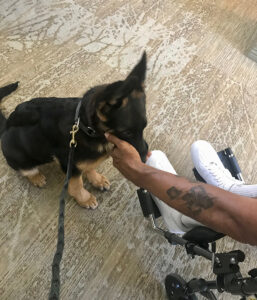By Fran Jewell

A question I am always asked is, “What should my dog be trained to do?” There are minimum safety behaviors any dog should learn. This is my list of should do’s and don’ts.
Should do’s:
Sit and wait at a door – to prevent darting out into the street or running someone over.
Sit for meals – this teaches dogs respect for humans and food.
Sit for petting – ANY time, not just with visitors.
Down or go lay down – this helps to teach self-control and what TO DO instead of fostering anxious behavior. Going to a bed on command is just as good. This can be combined with “stay.”
Leave it – leaving items on walks, like dead animals.
Puppy hugs – so the dog can go to the vet and not become afraid, resentful or angry when they are restrained. This is NOT something to start with an older or adoptive dog until you have developed a relationship with him.
Nail clipping – nothing is worse than having a dog afraid to have their nails clipped and having to pay someone to do it for the rest of a dog’s life.
Come – this is huge and life-saving and probably the most difficult to teach effectively.
Stay – again, this helps to teach the dog to trust you will always come back, but also teaches self-control.
Walking nicely on a leash – this is life safety for you and your dog. A dog that pulls you over can injure you severely and pulling can injure him as well.
Crate training – this is a life skill. Even for a dog that is well behaved at home, this is a skill for a dog to have. At some point your dog will have to go to the vet because he is sick. If he is stressed by a crate, his illness will be even more stressful for him, taking him longer to recover.
Be a leader – dogs will feel more comfort and TRUST with you if you let them know you are the leader. A leader is someone you can count on and one who gives direction. Allowing dogs to make their own decisions about most things in life will eventually lead to a dog that lives in constant anxiety. Dogs need to know someone is in charge, what the expectations are, and need boundaries to be mentally healthy.
Don’t Allow:
Jumping on counters – a dog that grabs a knife could experience a life-threatening injury, and the same for toxic food; i.e., chocolate or grapes.
Running between your legs – a surefire way to trip you, sometimes causing great injury to both of you.
Mouthing – this is disrespect and can lead a dog to believe that biting is also okay. It’s not affection.
Jumping on people – while many think this is “friendly,” it can cause someone to fall over, making YOU liable for any injuries. Additionally, it is disrespectful of your personal space. Yes, even dogs have personal space and understand that concept.
Food huarding – a dog that guards his food from other dogs or from people can become a dangerous dog, especially around children. Do not allow children to play near a dog’s food even if your dog seems non-food aggressive.
The longer you wait to do training, the harder it is to undo bad habits. Training can be incredibly fun for you and your dog. And it teaches the boundaries all dogs need to be happy.
Fran Jewell is an IAABC Certified Dog Behavior Consultant, NADOI Certified Instructor and the owner of Positive Puppy Dog Training, LLC in Sun Valley. For more information, visit positivepuppy.com or call 208-578-1565.


